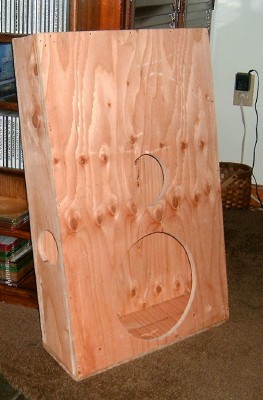Speaker box design is an artform. You can't bung a hole in a sealed box and expect it to perform properly. Neither can you just make a box any old size, drop a speaker in it, and expect it to perform.
You need to know a few things about the speaker before you can go about building a box for it. If you don't know anything about the woofer (model/TS parameters), then you are SEVERELY limited by the speaker box design.
If you don't know the driver specs, the best you can do (and expect reasonably decent) results is to make a sealed enclosure.
In general, for most woofers, larger (to a point) is better (bigger Vas of the box usually means lower resonance frequency; i.e., stronger bass). for 10" subs, I wouldn't go any larger than 0.75CuFT.
Here's a few things.
1) Internal dampening: Dampening on the insided will reduce "standing wave" interference within the box. Basically, it smooths out the response curve a little, since you will get some harmonic dB losses (based on box size and shape.) Also, the filler alters the resonance of the box itself, so it behaves (accoustically) like a box about 10% larger (12" driver, 1.0cuFt box)
2) Vents: Don't. Just... Don't. Bass-reflex boxes are picky about size and shape, and any deviation changes the sound completely.
3) Partitioning: I'd ALWAYS partition a box if there's more than 1 driver in it. For starters, not every sub is entirely the same, and little differences can add up considerably. Secondly, you can get some weird harmonics if the two subs don't get EXACTLY the same signal (I.e., running them in "stereo" or with poor signal mixing). And lastly, you get better cone control if the box volume is smaller.
4) Tweeters: I dont know why ANY car audio manufacturers still insist on doing this. Firstly, the sub is usually placed in an area that defeats the purpose of a tweeter (who the hell wants treble in the trunk? :wtf  and secondly, it means you have to supply a full range signal to the sub. Which goofs up the accoustics (since most of your music will sound like it's coming behind you) because below 80hz, sound is omnidirectional. Also, mixing bass lows (25-100hz or so) with mid-levels makes the bass muddy, since the sub has to work harder generating all the useless tones.
and secondly, it means you have to supply a full range signal to the sub. Which goofs up the accoustics (since most of your music will sound like it's coming behind you) because below 80hz, sound is omnidirectional. Also, mixing bass lows (25-100hz or so) with mid-levels makes the bass muddy, since the sub has to work harder generating all the useless tones.
To do it right, have ONLY a sub in a sub-box. If you insist on the tweets, put them up front where they belong. You don't even need a box for them (most of that type are compression-horn style anyway) so mount them in the dash. And get some kleenex, 'cos your ears are going to BLEED.
If you DO know the TS parameters of the sub, post 'em here, and I can design you an appropriate box.
EDIT: Oh, and one last thing; If at ALL possible, NEVER use plywood for box construction unless you are willing to brace the hell out of it internally. Plywood resonates all over the place. This means it will ring like a bell, and it will KILL any semblence of sound quality. The ONLY material of choice is MDF (Medium Density Fibreboard). MDF has much more neutral accoustical properties, and for the purposes of enclosure, is practically neutral.
Looks damn good; I'd suggest that you disassemble it, get some MDF, and use the existing peices as a template. You obviously have some skill with woodworking, so you know how to work with MDF... everyone else; MDF doesn't like being cut by anything except fine-toothed sawblades. Don't use a coarse rip-saw blade unless you want it to split and fray at the ends 
[This message has been edited by Mach10 (edited 01-13-2005).]






















